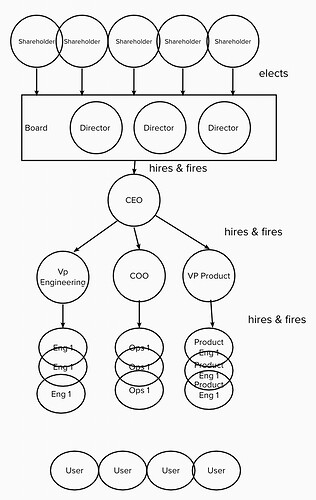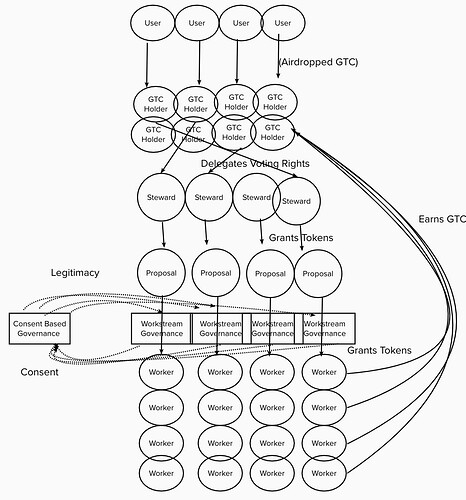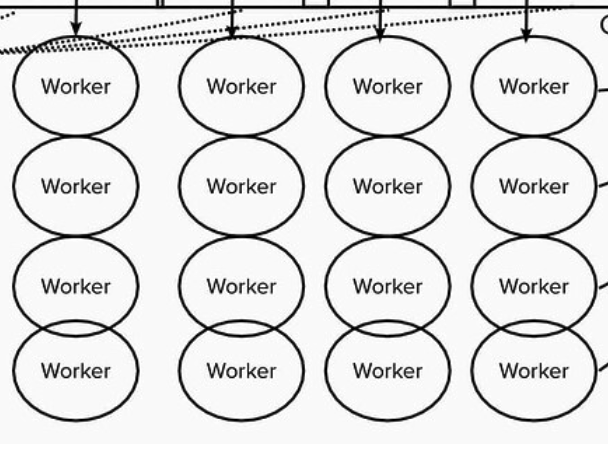Following my post on building GitcoinDAO’s legitimacy , I wanted to take a moment to articulate how Legitimacy flows in GitcoinDAO - specifically “legitimacy by process”. eg if a process is legitimate, the outputs of that process gain legitimacy.
While there are other ways to build legitimacy (read this post for more), “legitimacy by process” is an important part of how to judge which decisions within the DAO are legitimate, so this post focuses on that.
Goals of this post:
- Inform individual members judgements of what decisions are legitimate by process (or not). The hope is that every member of GitcoinDAO learns to judge the legitimacy of various actions on their own accord (without having to defer those judgements to more authoritative community members).
- Articulate why DAOs are more legitimate basis for a public goods-centric mission like Gitcoin’s than companies.
- By mapping out how consent flows in different organizations, we can map where legitimacy comes from (and perhaps spur some interesting discussions to keep legitimacy high).
Consent of the Governed
Why does consent of the governed matter?
From wikipedia:
the phrase consent of the governed refers to the idea that a government’s legitimacy and moral right to use state power is justified and lawful only when consented to by the people or society over which that political power is exercised.
This goes on:
This theory of consent is historically contrasted to the divine right of kings and had often been invoked against the legitimacy of colonialism
I think this is a very important (and timeless) first principle.
It is a principle that especially applies today as we migrate from web2 => web3. I believe that companies (especially web2 tech giants like Meta or Google) create their legitimacy through something that looks more like a Divine Right of Kings.
In web2, there are no property rights and we are all serfs on Zuckerberg’s land! Whereas well designed DAOs can derive their governance from the consent of the governed. This creates more legitimacy & a better platform for human thriving.
How Legitimacy flows in a Company like Meta
Lets take a look at how legitimacy flows in a company like Meta:
Legitimacy (high order social acceptance) flows from shareholders to the board to the CEO, and down an org chart.
Users are not asked for consent, other than perhaps to give a yay or nay to a 40 page terms of service document which they can not negotiate, only take or leave. This terms of service document may often dictate that any disputes must happen in a court of law that is halfway around the world from the end-users.
Because the users have no ability to consent to changes to the platforms ruleset, there will always be an incentive for management to try and extract from Users in order to service shareholders.
How legitimacy flows in a DAO.
Here is a shot at visualizing how legitimacy flows in a DAO like GitcoinDAO:
Here’s how the legitimacy flows from top to bottom:
- Users of Gitcoin from 2017-2021 were retroactively distributed governance rights to the Grants platform.
- These GTC Holders then have then delegated their governance rights to someone they trust (or to themselves) - what we call Stewards.
- Workstreams have their own governance to manage their internal affairs. Stewards grant tokens to workstreams via proposals. These proposals are from self-assembled members of the community who (if the proposal is accepted via the governance process ) perform work to earn further GTC. This could just mean being hired by a workstream lead, or it could mean being granted tokens through a more distributed means like through coordination party kit or Gitcoin | Explorer - depending on the governance structure of the workstream.
- Workstreams can also optionally choose to make legitimate decisions together that affect other workstreams to do things with consent based decision making.
- Workers in workstreams then deploy changes to the Grants platform, its ruleset, its terms, or its funds, which is then used to serve Users.
Consent of the governed
We repeat the principal we started with, from wikipedia:
the phrase consent of the governed refers to the idea that a government’s legitimacy and moral right to use state power is justified and lawful only when consented to by the people or society over which that political power is exercised.
Legitimacy should flow in circles, not just one way.
A priori, because consent (and therefore legitimacy) flows from the GTC Holders (which were seeded from Users) => the DAO => back again, the DAO is a more legitimate vessel for Gitcoin’s mission than other structures. As more surface area is opened for GTC, it is possible that this legitimacy could grow in the future. As the Grants platform becomes an immutable, open-source, & forkable protocol in the future, there will be even less agency for DAO workers to make changes that could be forced upon users, creating a “cant be evil” mantra that is better than web2’s “dont be evil” mantra.
Emperically, I am a strong believer that when people who govern any organization (company, nonprofit, DAOs, or otherwise) are a member of the communities they serve, they have longer term incentive alignment with those communities and less of an incentive to juice short term profits by extracting value from those users needlessly or by externalizing harm in these communities
Feedback welcome
These are just my opinions, and I’d love to hear from others.
What did I get right? What did I get wrong? What further improvements could be made? Are there any great visual maps of other DAOs we could look at for comparision? Please fork this mural and propose edits + Comment below.


